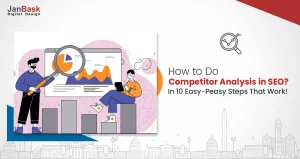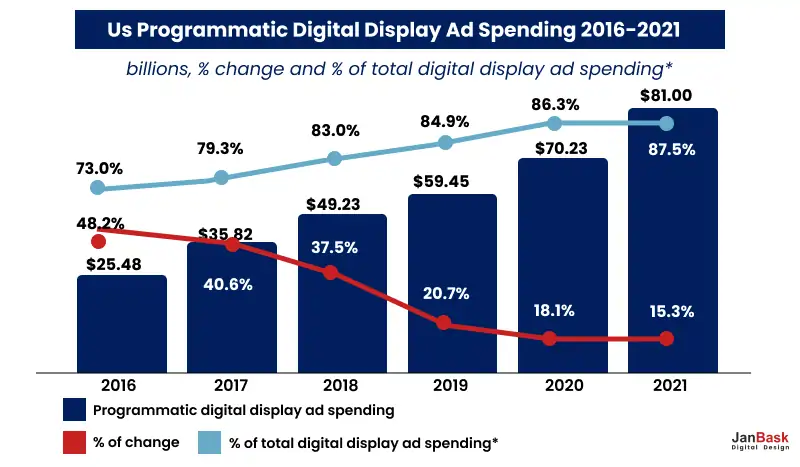
If you haven't implemented programmatic advertising or have only recently started to investigate it then the time is now until it gets too late. Globally, programmatic advertising is picking up the momentum across the globe. In the US and just over 80% of Europe, programmatic media buys account for 85% of all digital ad spending. Also, programmatic media buys this year are anticipated to make up 68% of all digital ad expenditure worldwide. So, what exactly is programmatic advertising, and is it appropriate for you?
Let's understand what Programmatic marketing is and also the best practices through some relevant case studies.

Unlock the Power of Programmatic Ads Now!
Programmatic advertising, at its most basic, is the technology used to buy and sell digital ads. Programmatic advertising uses an automated approach to advertiser-defined criteria to purchase digital ad content across the web, mobile, apps, video, and social media.
It is an automated way of buying and selling digital advertising space in real-time. This eliminates the need for human intervention in the process, which in turn reduces the time and costs involved. Programmatic advertising uses data and algorithms to target the right audience at the right time, ensuring more efficient and relevant advertising. It has transformed the advertising industry by making it easy for advertisers to reach their target audience and optimize their campaigns for maximum impact. Programmatic advertising has shifted the focus from media buying to audience buying, making the process more transparent and effective.
When a visitor accesses a programmatic advertising page, the marketplace creates a marketplace for companies interested in bidding to place ads on this page. This is sometimes referred to as an ad-impression auction.
If the person who visits the page is from a company’s target market, the company gains access to the marketplace. Many advertisers compete for this ad space, but only one emerges as the winner. The company with the highest bid wins the spot and its ad appears on the page.
The most important aspect of this process is that it is spontaneous. Even though everything seems to take minutes, it all happens in milliseconds. The winner of the auction is chosen before the page loads for the user.
This happens because companies set their maximum costs in advance. Like their competitors, they decide how much they want to pay. If advertising space is available, bids are compared and calculated to provide adequate space for businesses.
The company ad appears when the page loads. Advertising may only have an impact on an individual user, but it is still valuable. Also, the person is more likely to click on the ad due to its relevant content.
This may seem like a confusing process, but it’s a simple process that takes milliseconds. Let’s talk about how systematic trading works in a simple way:
Customers respond to the ad by clicking on it and making a purchase.
You can choose the frequency and timing of your bid when you bid. If you know your target audience has access to the internet throughout the day, you can easily tailor your campaign to pay advertising costs to bid on ad spaces to meet your criteria.
This is a huge advantage for your company as it allows you to focus more on your target market. You can reach them when they come online.
It also prevents you from throwing off your money. You probably won’t spend money or money on ads that your target market doesn’t see. This allows you to better target your products to reach your target market.
You can set your own price with this method. As with pay-per-click (PPC) advertising, you set a maximum bid that you are willing to spend.
The ability to set a bid makes programmatic marketing an easy and flexible option for your business since you can choose how much you want to spend on the bids.
When you can set the pricing, you have more influence over your whole advertising budget.
You only pay for relevant impressions when you use programmatic advertising. You don’t set up a blanket campaign hoping to reach certain people in your target market. This method only helps you get the right impression you are looking for.
You can specify the number of impressions you want. This ensures that you reach your campaign goals.
If you only pay for relevant impressions, you are putting your money on those most likely to convert. This gives you a great return on investment (ROI) for your business.
Programmatic marketing allows you to target a specific audience
This is an effective marketing strategy because you can see the kind of content that resonates with your target demographic. You can easily identify the factors that make visitors click on your ads and the factors that make a positive impression on your target demographic.
These ads can also be used to improve user experience. Since you are targeting these customers with personalized ads, they are more likely to click on the ad. Ads target the audience who are most likely to convert, allowing you to better target your market.
Create objectives with this marketing that are feasible and attainable. You don’t just put your ad in front of the audience and hope they convert. Instead, you can set specific goals for yourself.
Once you decide on a goal, you can follow up with specific people who can help you in achieving it. Your goals can range from brand recognition to conversion. This is a versatile strategy because of the ability to set goals.
Programmatic advertising is flexible and adaptable in many ways. The ability to use programmatic advertising across different media is one of the best things.
You can use it on an app, video, or desktop computer. As a result, programmatic marketing is a great option because it allows you to optimize your ads for the most effective channels.
You can customize your ads to reach your target market if you know that a large proportion of them would be searching and browsing on mobile devices. This allows you to communicate with individuals through their preferred channels.
Now that we understand the benefits of programmatic advertising, let’s look at how you can use it in a digital marketing campaign.
The first step is pretty straightforward: do some research and find out what’s to be included. Take the time to familiarize yourself with the many new concepts and terms that are introduced to you as a marketer stepping into this new realm of advertising.
Search for relevant glossaries of programmatic advertising terms online to gain knowledge and learn how to distinguish between your SSP and DSP.
Like any part of digital marketing services, it’s important to set clear objectives from the beginning. You need to use existing data to decide what kind of advertising skills you need and develop an effective strategy to determine short-term and long-term goals.
While programmatic advertising is based on machines and algorithms, there’s still a human element in it. A variety of platforms are available, some offering fully or partially managed services that allow you to manage your programmatic procurement activities.
The next step is to hire experienced marketers to plan, manage and optimize your buying. For maximum performance, you ultimately need to find the best balance of automation and intelligent human interaction. As a result, you don’t have to rely solely on algorithms to get the best results for your campaign.
One disadvantage of programmatic advertising is that, due to its reliance on algorithms, ads appear in inappropriate places, such as on websites that promote misinformation about various political parties and individuals
To avoid this, make sure your demand-side blacklist is regularly updated and checked for inappropriate URLs. It’s especially convenient when platforms allow users to remove entire categories from ad spend.
Another option, necessary if your product is sensitive, is to use a whitelist. This results in approved sites rather than denials. This can increase costs by limiting the audience you can reach, but it will keep your ads from being associated with any obvious or offensive content.
When you contact a company, make sure they take all reasonable precautions to avoid showing your ads on important or negative websites.
Viewability for programmatic ads generally ranges from 44% to 55%, but fraud costs online advertisers between $6.5 billion and $19 billion annually, according to eMarketer estimates Consumer privacy is a factor that hurts advertisers, especially mobile and connected screen TV (CTV).
So how can your company combat fraud? The first step is to compare the budget and the target audience. Marketers have been preoccupied with reach in programmatic advertising, which exposes the campaigns to bot exploitation. If a deal looks too good to be true while bidding for advertising space, it generally is! Try not to obsess about reach but instead, combine it with traffic quality to prevent generating fake traffic.
Your company can also make sure that ads adhere to privacy laws.
Programmatic ads are successful because it’s efficient, targeted, and scalable. Over $61 billion was spent on programmatic advertising by US advertisers in 2021. That amount is anticipated to increase to $133 billion in 2023, representing 91% of all digital advertising spending.

According to eMarketer, this growth has exceeded earlier expectations and is partly because of the region's quick recovery from the COVID-19 pandemic and the advancement of artificial intelligence and how it is affecting marketing.
The system functions and is in use, because it uses resources and time effectively.
Programmatic advertising aims to do away with manual, hit-and-trial campaign creation. It was well known for charging marketers substantially too much money.
You can now rely on an algorithm to decide how to best spend your ad budget with programmatic advertising, You only need to input data about your campaign, audience, and key performance metrics into your programmatic solution information, and the algorithm will do the work for you.
The system not only launches campaigns but also tracks your ad spending to find growth opportunities,
If you're looking to optimize your ad budget, increase your organization's ROI, and connect with your target audience, programmatic advertising has the potential to help your business succeed well.
Regardless of the size of your company, programmatic marketing has a lot of potential. If you don’t know what programmatic marketing is, you’re way behind the queue. Currently, companies are investing $60 million a year in programmatic advertising, a figure that only continues to grow, and demonstrates the effectiveness and impact of programmatic marketing across advertising strategies
You should give programmatic advertising a try if you want to improve your online ad strategy.
While you can begin the process internally, a programmatic service provider can help you move it forward more quickly. With an experienced team of ad specialists from a programmatic service provider, you can build, launch, and manage your ad campaigns.
If you’re planning to consider programmatic marketing, you’re probably wondering if it’s the best option for you. Does it work with your marketing strategy? What are the possibilities of your campaign?
Here are some suggestions you may find useful.

The Economist's award-winning campaign generated a substantial return on investment.
The ad was able to target interested visitors with provocative, clever, or funny titles whose cookies meant they didn’t spend too much time on the Economist’s website putting the book together.
The results were amazing. According to e-consultancy, 650,000 new prospects were created, 3.6 million people were pushed to action and a campaign ROI of 10:1 was achieved on a media investment of £1.2 million
This equates to a 64% increase in awareness and a 22% increase in perceptions in the US. - A unique achievement in anyone’s book.

Audi aimed to keep its marketing efforts relevant and created a campaign that really matched its iconic phrase 'Vorsprung durch Technik' ('Progress through technology') in preparation for the introduction of the convertible vehicle.
Audi implemented Display and Video 360 in close partnership with Google and took a data-driven approach that integrated all customer data rather than relying on siloed information. The marketing team then applied programming strategies to enhance their valuable customer touchpoints.
In addition to collecting behavioral data to improve the marketing segmentation, the company allowed customers to customize their dream car online from a catalogue of 6,000 different options available. These individual designs were used to create dynamic ads that performed twice as well as the normal commercial ads. Programmatic ads performed fourfold than the normal traditional ads boosting car sales.
These campaigns demonstrate the power of programmatic advertising to increase engagement and conversion rates by targeting the right customers at the right time. While many marketers find programmatic complex and complicated, once you get the hang of it, it’s a simple and flexible approach.
1. What are Programmatic Ads?
The process of purchasing digital ad space using algorithmic software or a data-driven platform is referred to as programmatic advertising.
If you're wondering why this word is still used (although digital ad buying is the industry standard), it's because traditional media buying entails more labour-intensive tasks. To begin, contact a publisher (owner of a newspaper, magazine, or online), obtain a media kit, negotiate a contract, and prepare insertion orders for each placement of your campaign.
All of these jobs, however, are automated with programmatic advertising. Find a programmatic ad platform, upload your creative, choose your target audience, and bingo! You're all set to deliver your ad across a whole ad network.
2. Where Can You Find Programmatic Ads?
Programmatic advertising is all over the place. The majority of the ads you see are delivered programmatically, from social media platforms and podcasts to magazines and newspapers to website banners.
3. What are the advantages of programmatic advertising?
Programmatic advertising is good for your brand’s bottom line and general efficiency:
4. How does programmatic advertising work?
In programmatic advertising, ad space is bought and sold in real time through a demand-side platform (DSP).
DSPs enable marketers to target specific audiences based on criteria such as demographics, device types, interests, and behaviors. Once this data is collected, the DSP will use real-time strategic bidding to compete for ad spots on relevant websites, channels, and publications most relevant to your target demographic.
5. How much does programmatic advertising cost?
The answer is everything depends. Programmatic advertising is typically charged per thousand impressions (CPM) and ranges from $0.5 to $2. The higher the cost, the more competitive, targeted, and positioned your business is.
In general, programmatic advertising is still cheaper than traditional media buying because it relies on real-time advertising rather than bulk ad buying.
6. What are some of the best practices to keep in mind?
You can learn these best practices because they are the same as those of starting digital ads:
Businesses and advertisers seek safe and efficient methods of marketing their products and services. Programmatic ad buying of digital media is the solution. Businesses can now locate ad tech systems (programmatic marketing) by utilizing secure mass payout automation solutions.
These automated payment systems will advance and expand alongside technology and enterprises. Companies use programmatic technology to run efficiently, and the software handles the advertising.
Interested in our Web Design & Development Services?

L
Easily the best explanation of programmatic advertising on YouTube without any fluff. Thank you for what you do and this was definitely a great refresher for me 🙂 Keep the good work going!
C
Great explanation. I’ve worked in advertising for the past three years and have come to learn it in practice but seeing it all written out like this is very helpful for those coming into the industry or just seeking to learn how digital advertising works!
M
I really appreciate the way you explain the technical details. Just wanted to check if someone from a non-technical background is really interested in learning media buying and programmatic marketing, then from where he should start? If you have any step-by-step courses please let me know. Before suggesting, please consider myself zero in detail marketing. Thank you.
R
This blog is your comprehensive guide to mastering the art of data-driven advertising.
A
This blog is incredibly helpful! I’ve always been confused by these web terms, but your explanations are so clear. Thank you for demystifying them!